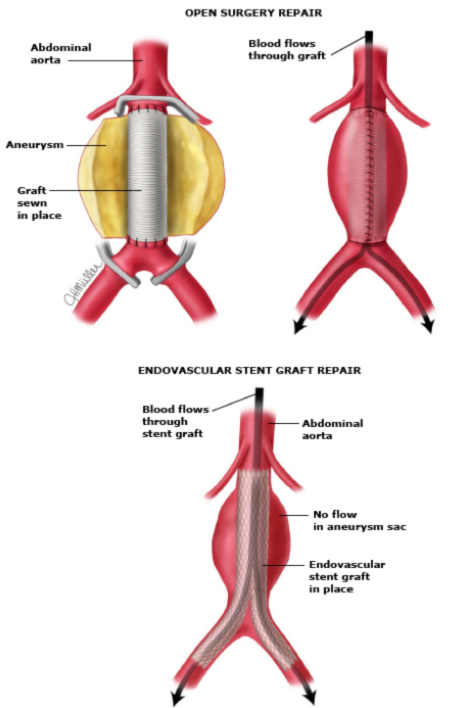Abdominal Aortic Aneurysm
What is an abdominal aortic aneurysm? — An “abdominal aortic aneurysm” is a problem in the aorta, the main blood vessel that comes out of the heart. Blood flows through the aorta to the rest of the body. The “abdominal aorta” is the part of the aorta that goes from the heart, down through the belly, and then branches to supply blood to the legs. In people with an abdominal aortic aneurysm, also known as an “AAA,” a part of the abdominal aorta balloons out or bulges. If the bulge bursts, the condition becomes very dangerous. A burst aorta causes lots of internal bleeding.
What are the symptoms of an AAA? — Most people with abdominal aortic aneurysms have no symptoms. When symptoms do occur, they can include:
- Pain in the belly or back
- A small lump in the upper part of the belly that pulses, meaning it swells and shrinks in rhythm with the heartbeat (your surgeon will notice this more often than you do)
Abdominal aortic aneurysms can burst with no warning. Doctors suggest you get tested if there is a high risk that you might have the condition.
Who is most likely to get an AAA? — Your risks go up if you are:
- Male
- Are older than 60 (with every year of life after that, your risk goes up even more)
- Smoke
- Have family members who have had the condition
- Have heart disease or other conditions that affect the blood vessels
Can AAAs be prevented? — No. But you can greatly reduce your risk by not smoking. If you have high blood pressure, it is also important to control your blood pressure.
Is there a test for AAAs? — Yes. The most common test is called abdominal ultrasound. Which can be performed by one of our experienced vascular sonographers on premises at VVC.
How are AAAs treated? — That depends on how big the aneurysm is. Some people need surgery to repair the aneurysm. Others do not.
You might not need to have your aneurysm repaired right away if your aneurysm is smaller than 4 centimeters (1.6 inches) wide or if it is growing slowly.
What should I do if I have an AAA but don’t need surgery? — Your surgeon will suggest that you:
- Get tested every 6 months to 3 years, depending on how big your aneurysm is, to see how fast your aneurysm is growing
- Take a beta-blocker – This is a medicine that slows the growth of abdominal aortic aneurysms.
- Call your doctor if you start having pain in your belly or back. Pain can be a sign that the aneurysm is bursting.
When should AAAs be repaired? — Repair is the best treatment if your aneurysm is at risk of bursting. Here are some signs that yours might burst:
- It is bigger than 5.5 centimeters (2.2 inches) wide
- It grows more than 0.5 centimeters (0.2 inches) in 6 months
- You have other conditions that affect your blood vessels
- Your aneurysm is more than twice as big as your aorta should be
How are AAAs repaired? — Aneurysms can be fixed in one of two ways:
- Traditional “open” surgery – For open surgery, the surgeon cuts open your belly and replaces the bulging part of the aorta with a tube called a “graft.” This tube is made from manmade materials. It is sewn into place. Blood can flow normally through it.
- Endovascular stent graft – To repair the aorta with an endovascular stent graft, the surgeon goes into a blood vessel in your groin and inserts a folded graft. Then the surgeon threads the graft up to the bulging part of the aorta and unfolds it. This type of graft is not sewn into place, but it is held tightly against the normal aortic wall above and below the anueryrum. Blood flows through the graft.
What should I know about the two repair options? — Open surgery carries a higher risk, and endovascular repair is preferable if the anatomy is suitable. But it will require long term follow-up and monitoring.
Large Abdominal Aortic Aneurysm
Aneurysm now treated with stent graft
Insertion of stent graft to treat aneurysm


